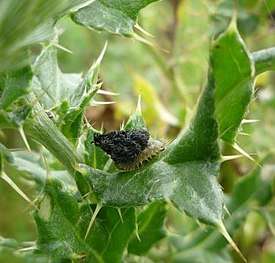Thistle tortoise beetle
The thistle tortoise beetle (Cassida rubiginosa) is a species of leaf beetle, situated in the subfamily Cassidinae (tortoise beetles) and the genus Cassida.
| Thistle tortoise beetle | |
|---|---|
 | |
| Scientific classification | |
| Kingdom: | |
| Phylum: | |
| Class: | |
| Order: | |
| Family: | |
| Genus: | |
| Species: | C. rubiginosa |
| Binomial name | |
| Cassida rubiginosa Müller, 1776 [1] | |
Description

C. rubiginosa measures 6.0–8.0 mm in length. Like all Cassida its head is covered by the pronotum and the elytra has a wide flange surrounding it. This species is highly rounded, with green or yellowish-green elytra, sometimes with a small fark triangular spot around the scutellum.[2] The common name may be misleading for the identification of this species as "rubiginosus" is Latin for "rusty or rust-coloured").[3]
Flagellum
The flagellum (male sex organ) of C. rubiginosa is actually longer than its body — the organ is also very thin and curved at the end. The beetle needs such an organ because of the shape of the female reproductive organ, which includes a coiled duct that the male must penetrate. These physical properties were studied in a 2017 research project because the mechanically challenging ability of a thin structure to penetrate without buckling or rupturing may have important implications for the development of catheters in modern medicine.[4]
Distribution
It is a species recorded in Britain and is native to Eurasia. The beetle was intentionally introduced to Virginia to control thistles. It has spread to the northern United States, following accidental introduction to Quebec in 1901. In Canada it has also spread to New Brunswick, Alberta,[3] and has been seen as far south as Colorado. C. rubiginosa was introduced to New Zealand in 2006 for use as a biological control agent.[5]
Diet and habitat
C. rubiginosa feeds on various Asteraceae, including thistles and many others. The adults are usually found on the underside of the leaves, the larvae on the uppersides. Adults may also feed on pollen of buttercups and ox-eye daisies.[6] The beetle's consumption of these plants is facilitated by a symbiotic relationship with the bacterial symbiont Stammera, which is housed in specialised structures within the foregut and allows the beetle to digest pectin, which is indigestible to most animals.[7]
 Cassida rubiginosa larva carrying package of dried frass on its back
Cassida rubiginosa larva carrying package of dried frass on its back Cirsium arvense suffering from feeding damage caused by Cassida rubiginosa adults and larvae
Cirsium arvense suffering from feeding damage caused by Cassida rubiginosa adults and larvae
As a biological control agent
C. rubiginosa was introduced to New Zealand for use as a biological control agent against Cirsium arvense (Canada thistle) in 2006.[5] It is estimated that Canada thistle costs landowners around $32 million per year in Otago and Southland alone.[8]
In terms of its efficacy as a control agent for Canada thistle; in dry years in Virginia, United States, five parasite-free beetles per plant have been shown to reduce above ground thistle biomass by 88%, with only 25% of these plants surviving to the end of the following year. In wet years the impact was less but still substantial.[5] The beetle has subsequently been traded around New Zealand as a control agent. For example, in 2016 beetles collected from Ngāruawāhia were released in Duder Regional Park in exchange for a group of the adult beetle Neolema ogloblin, which is a biological control agent for Tradescantia fluminensis.[9]
References
- "Cassida rubiginosa". Integrated Taxonomic Information System.
- Hubble, D. (2012). Keys to adults of seed and leaf beetles of Britain and Ireland. Field Studies Council. p. 113. ISBN 978-1-908819-08-6.
- "Species Cassida rubiginosa - Thistle Tortoise Beetle". bugguide.net. Retrieved 27 August 2018.
- Yoko Matsumura; Alexander E. Kovalev; Stanislav N. Gorb (2017). "Penetration mechanics of a beetle intromittent organ with bending stiffness gradient and a soft tip". Science Advances. 3 (12). doi:10.1126/sciadv.aao5469. PMC 5738233.
- "THE BIOLOGICAL CONTROL OF WEEDS BOOK: GREEN THISTLE BEETLE" (PDF). TE WHAKAPAU TARU. 2010. Retrieved 27 August 2018.
- "Cassida rubiginosa Müller, O.F., 1776". UK Beetle Recording (NERC- Centre for Ecology & Hydrology). Retrieved 27 August 2018.
- Hassan Salem; Eugen Bauer; Roy Kirsch; Heiko Vogel; Hakema Fukatsu; Martin Kaltenpoth (2017). "Drastic Genome Reduction in an Herbivore's Pectinolytic Symbiont". Cell. 171 (7). doi:10.1016/j.cell.2017.10.029.
- "Beetles to battle $32m-a-year thistle problem". The Southland Times. Retrieved 22 November 2011.
- "The great beetle swap". Auckland Council. 7 December 2016. Retrieved 27 August 2018.
External links
- Global biodiversity information
